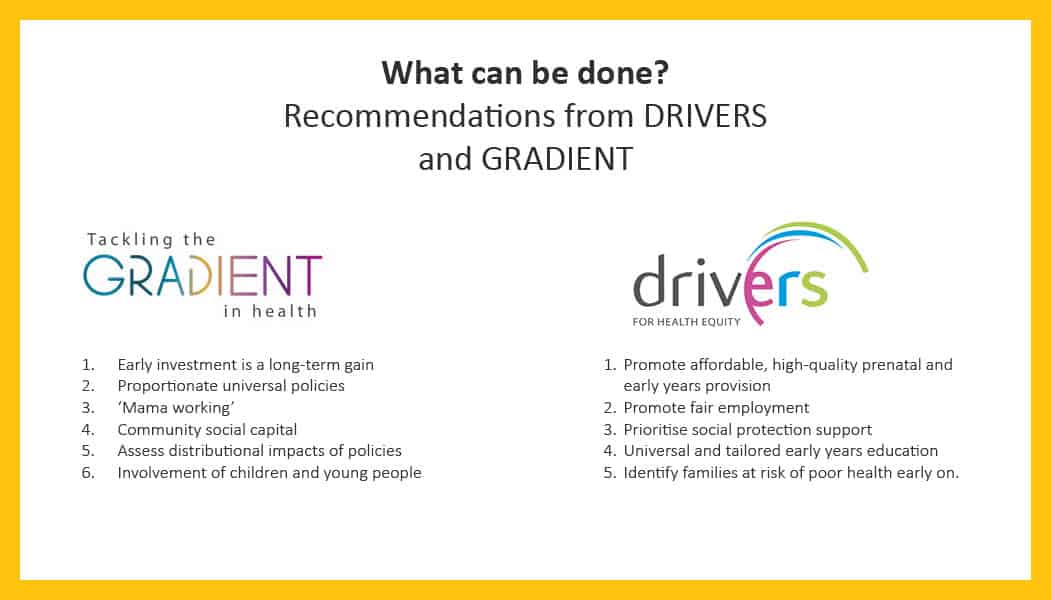For every step down the socio-economic ladder, children and young people experience a higher level of physical and mental health problems that will affect their future health and life opportunities. The association between family affluence and children’s health and well-being outcomes is evident across Europe. Neighbourhood deprivation, lower parental educational attainment, parental job strain or unemployment, and household material deprivation are all factors that are linked with a wide range of adverse child health and developmental outcomes.
By Caroline Costongs
Children currently represent 20% of the EU population; by 2050 they will represent only 15%. If those children do not achieve their full potential in terms of mental, physical and social wellbeing, it will be a significant loss to European societies – a loss we cannot afford.
What can we do? Results from EuroHealthNet’s former research projects GRADIENT and DRIVERS suggest a variety of entry points for action.
The rich selection of articles in this magazine reflect a wide range of activities by public health and health promotion professionals across Europe. This is the first time we have run a themed edition of the magazine, covering the main theme of EuroHealthNet’s work this year: children and young people. I hope that the articles serve as a source of inspiration for your own work and for improving all young people’s lives.
In our two articles on healthy diets for children, we look at two approaches being taken in Austria. One specifically targets children aged 4-10; it is creating new resources and testing new communication styles for children, care-givers, and educators. The other takes a holistic approach to promoting healthy diets by looking at individuals, families, environments, and the societal and legal structures in which they live from the perinatal period until 10. We also learn about what makes food aid and nutrition programmes in schools successful, with new results from the DIATROFI programme in Greece. The research team there is asking: what is the best way to reduce food insecurity and obesity in schools? What is the effectiveness of distributing vouchers compared to healthy meals? What has the biggest benefit: healthy meals, education, or both? Read on to discover their conclusions.
We know that post-industrial decline in many areas of Europe is affecting the health of current and future generations. In one such area, Cwm Taf in Wales, the whole public sector is working together to try to improve the health of babies and their families. The health, police, education, social, probation, and fire and rescue services are working together with the national government and even the natural resource agency in order to map, connect, and improve services.
The development of young minds – starting in the prenatal stage – is the topic of an article from CHAIN, the new centre for global health inequalities research, based in Trondheim, Norway. It explores how exposure to toxic environmental chemicals affect brain development, and the links to health inequalities.
You may already be familiar with the concept of ‘positive parenting’ – parental behaviour which nurtures, empowers, guides, and recognises children as individuals in their own right. In the Spanish Health Promotion and Prevention Strategy (HPPS), it has been combined with a health promotion approach, to support children and their families across the life course. Resources have been developed for families (online training, national recommendations, and a website on healthy living); for health professionals; and for education professionals. Local authorities are also being brought on board. We hear about the actions taken and the rationale behind them.
Becoming a parent can be exiting but challenging time. Those challenges can lead to mental ill-health which is harmful for parents, families and children. A new international initiative, ‘PATH’ is aims to enable women, families, healthcare professionals, and employers to prevent, diagnose and successfully manage mild and moderate perinatal mental health issues, leading to happier and healthier families. We look at their plans for the next three years.
There are many different examples of interventions in pre-and post-natal education and parenting support programmes, but how do we start to evaluate how they affect health inequalities? The Regional Health Promotion Documentation Centre DoRS in Italy has produced two reports on the topic. In their article, we hear why they focus on the importance of the nurturing care framework, and the need to build healthy environments by looking at the micro and macro level.
Family support and a health monitoring model that centres prevention and promotion is the driving philosophy behind the work of the Nossa Senhora do Bom Sucesso Foundation in Portugal. Read on to find out more about their model and using nurses as trusted gate keepers for families.
Teenage years are full of changes. It’s a vital time to learn about and develop good mental health – an important asset for young people as they find their own way in the world, and protect them in later life. In this edition we cover two different approaches. The Youth Aware of Mental Health (YAM) programme developed in Sweden, creates space for 13-17-year-olds to learn about and discuss their mental health. Starting from a set of pedagogical materials, emphasis is put on peer support and where to turn for professional help. The Saving and Empowering Young Lives in Europe (SEYLE) project, which evaluated school-based programmes found the intervention to be highly effective. From Belgium we learn about a new e-coaching platform for young people aged 12-16 ‘NokNok’, which aims to build young peoples’ resilience through online coaching, tips, and peer support. It uses gamification, community building, and persuasive system design. Young people themselves were instrumental in the design of the programme, resulting in its recent successful launch.
At the European level, changes are underway, with a new parliament and commission beginning to settle in. Our article on why it’s time to invest in children’s wellbeing looks at the policy landscape – where it leaves us now and where we can go in the new legislative period.
Children and young people are our main assets. I hope you enjoy reading the articles in this themed edition of our magazine. Please do not hesitate to give us your feedback.
I wish you a nice summer,
Caroline Costongs
Director EuroHealthNet

Caroline Costongs
Caroline Costongs is Director of EuroHealthNet.

